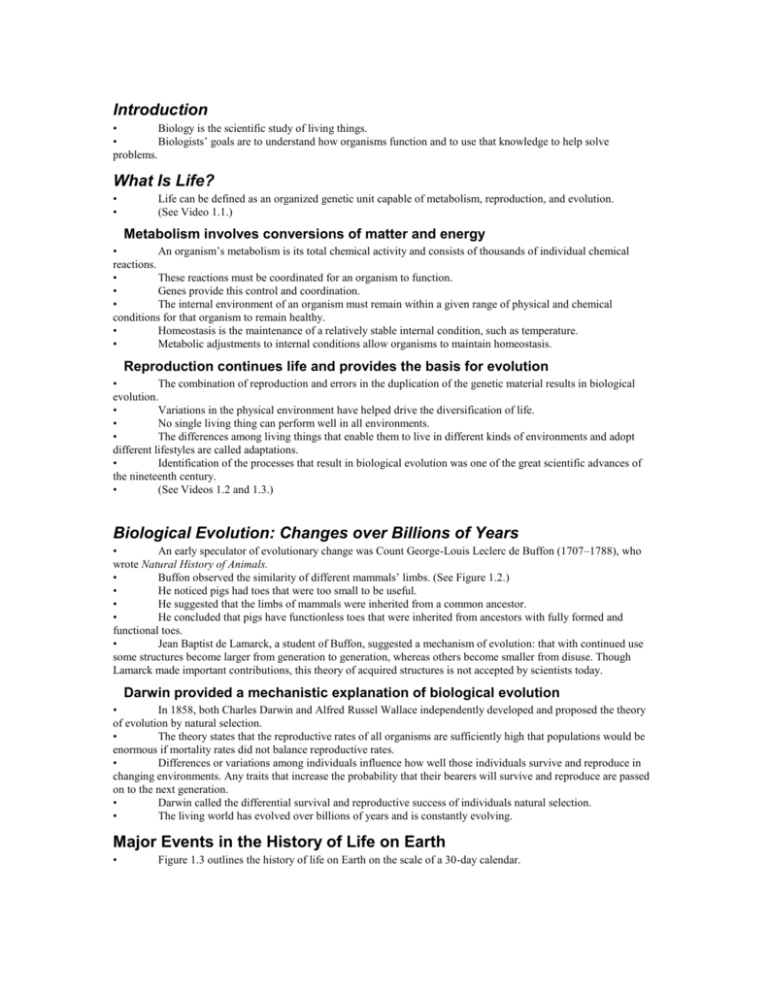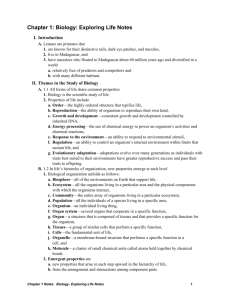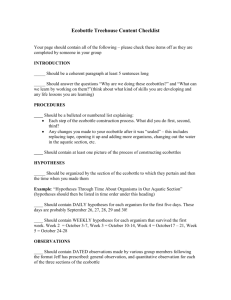Lecture Outline - Cedar Crest College
advertisement

Introduction • Biology is the scientific study of living things. • Biologists’ goals are to understand how organisms function and to use that knowledge to help solve problems. What Is Life? • • Life can be defined as an organized genetic unit capable of metabolism, reproduction, and evolution. (See Video 1.1.) Metabolism involves conversions of matter and energy • An organism’s metabolism is its total chemical activity and consists of thousands of individual chemical reactions. • These reactions must be coordinated for an organism to function. • Genes provide this control and coordination. • The internal environment of an organism must remain within a given range of physical and chemical conditions for that organism to remain healthy. • Homeostasis is the maintenance of a relatively stable internal condition, such as temperature. • Metabolic adjustments to internal conditions allow organisms to maintain homeostasis. Reproduction continues life and provides the basis for evolution • The combination of reproduction and errors in the duplication of the genetic material results in biological evolution. • Variations in the physical environment have helped drive the diversification of life. • No single living thing can perform well in all environments. • The differences among living things that enable them to live in different kinds of environments and adopt different lifestyles are called adaptations. • Identification of the processes that result in biological evolution was one of the great scientific advances of the nineteenth century. • (See Videos 1.2 and 1.3.) Biological Evolution: Changes over Billions of Years • An early speculator of evolutionary change was Count George-Louis Leclerc de Buffon (1707–1788), who wrote Natural History of Animals. • Buffon observed the similarity of different mammals’ limbs. (See Figure 1.2.) • He noticed pigs had toes that were too small to be useful. • He suggested that the limbs of mammals were inherited from a common ancestor. • He concluded that pigs have functionless toes that were inherited from ancestors with fully formed and functional toes. • Jean Baptist de Lamarck, a student of Buffon, suggested a mechanism of evolution: that with continued use some structures become larger from generation to generation, whereas others become smaller from disuse. Though Lamarck made important contributions, this theory of acquired structures is not accepted by scientists today. Darwin provided a mechanistic explanation of biological evolution • In 1858, both Charles Darwin and Alfred Russel Wallace independently developed and proposed the theory of evolution by natural selection. • The theory states that the reproductive rates of all organisms are sufficiently high that populations would be enormous if mortality rates did not balance reproductive rates. • Differences or variations among individuals influence how well those individuals survive and reproduce in changing environments. Any traits that increase the probability that their bearers will survive and reproduce are passed on to the next generation. • Darwin called the differential survival and reproductive success of individuals natural selection. • The living world has evolved over billions of years and is constantly evolving. Major Events in the History of Life on Earth • Figure 1.3 outlines the history of life on Earth on the scale of a 30-day calendar. Life arose from nonlife via chemical evolution • All matter is made of chemicals. • The smallest units are atoms. • Chemical evolution led to the appearance of life about 4 billion years ago. • Random inorganic chemical interactions eventually produced molecules that had the property of acting as templates to form similar molecules. • Some of these large molecules—carbohydrates, lipids, proteins, and nucleic acids—are found in all living systems. Biological evolution began when cells formed • Around 3.8 billion years ago certain molecules became enclosed in compartments. • Control over entrance, retention, and exit of molecules was possible because of compartmentalization by membranes. • Under present conditions on Earth, cells do not arise from noncellular materials, but must come from other cells. • For 2 billion years, cells were tiny packages of molecules, each enclosed in a membrane. • These were prokaryotic cells, which lived separately from one another and had no internal membraneenclosed compartments. Photosynthesis changed the course of evolution • About 2.5 billion years ago some prokaryotes acquired the ability to photosynthesize. • The energy of sunlight was captured, and oxygen was generated as a waste product. • Oxygen slowly increased in concentration in the atmosphere, making much more efficient metabolism possible. • Another effect of O2 was O3 (ozone) accumulation in the upper atmosphere. • Ozone has the property of preventing excess ultraviolet light from the sun from reaching Earth. • Around 800 million years ago, ozone accumulation shielded the landmass from radiation adequately enough to allow the movement of organisms to land. • (See Video 1.4.) Cells with complex internal compartments arose • • cells. • Some prokaryotic cells became large enough to attach, engulf, and digest smaller cells. (See Figure 1.5.) About 1.5 billion years ago, some cells had surviving smaller cells within them: These were early eukaryotic In contrast to prokaryotes, in modern eukaryotes genetic information is compartmentalized in a nucleus. Multicellularity arose and cells became specialized • Until slightly more than 1 billion years ago, only unicellular organisms existed. • Two developments made the evolution of multicellular organisms possible: • The ability of a cell to change its structure and functioning to meet the challenges of a changing environment. • The ability of cells to stick together after they have divided and to act in a coordinated manner. • Once organisms began to be composed of many cells, it became possible for certain cells to specialize to perform specific actions, such as photosynthesis. • (See Video 1.5.) Sex increased the rate of evolution • The earliest unicellular organisms reproduced asexually—by doubling their hereditary material and then dividing into two new identical cells. • Sexual recombination, the combining of genes from two cells, appeared early in the evolution of life. • Sex increased the rate of evolution because an organism that exchanges genetic information with another individual produces offspring that are more genetically variable. Because environments are constantly changing, organisms that produce variable offspring have an advantage over those that produce genetically identical clones. Levels of Organization of Life • Biology can be visualized as a hierarchy of units that include molecules, cells, tissues, organs, organisms, populations, communities, and the biosphere. (See Figure 1.6 and Animated Tutorial 1.1.) • The organism is the central unit of study in biology. • To understand organisms, biologists must study them at all levels of organization, from low to high. • (See Videos 1.6 and 1.7.) The Evolutionary Tree of Life • All organisms on Earth today descended from an original unicellular organism that lived around 4 billion years ago. • Major evolutionary events have led to more complex organisms with larger quantities of information and more complex mechanisms for using it. • Genetically independent groups, called species, have evolved. • If individuals of a species are separated into isolated populations, differences between the populations may accumulate over time, and the isolated groups may evolve into different species. These splits in populations are known as speciation events. • Since all organisms evolved from the same original organisms and have been evolving for the same length of time, terms like “primitive,” “advanced,” “lower,” and “higher” are best avoided. The terms simple and complex refer to an organism’s level of complexity; the terms ancestral and derived distinguish characteristics that appeared earlier in evolution from those that appeared later. • All organisms alive today are the exceptional survivors of eons of generations of life, and they have survived because of adaptation to their environments. (See Figure 1.7.) • As many as 30 million species may live on Earth today. • The unfolding of speciation events can be expressed as an evolutionary “tree,” with organisms grouped in ways that attempt to define their evolutionary relationships, or how recently the different members of a group shared a common ancestor. (See Figure 1.8. and Animated Tutorial 1.2.) • Using data from a variety of sources, including the fossil record and modern techniques of DNA sequencing, the U.S. National Science Foundation’s Assembling the Tree of Life (ATOL) project aims to determine the evolutionary relationships among all species on Earth. The Tree of Life will be an information framework for biologists in much the same way that the periodic table is an information framework for chemists. • Biologists have assembled a provisional tree of life. (See Figure 1.8.) • Three major life domains form the hierarchical scheme: Archaea and Bacteria (prokaryotes), and Eukarya (eukaryotes). • Eukarya are divided into four groups: the protists, and the kingdoms of Plantae, Fungi, and Animalia. • Some bacteria, some protists, and most members of Plantae convert light energy to chemical energy by photosynthesis; these are autotrophs (“self-feeders”). • Fungi and Animalia are heterotrophs (“other feeders”) and must rely on energy-rich molecules made by other organisms. • See Figure 1.8 for a simplified version of the hierarchical levels. • Each species is identified by two names. • The first, the genus name, refers to a group of species that share a recent common ancestor. • The second, the species name, identifies a single species with the genus. • The scientific name of modern humans is Homo sapiens. • (See Video 1.8.) Biology is a Science Conceptual tools guide scientific research • Underlying most scientific research is the hypothesis-prediction (H–P) approach, which allows scientists to modify and correct their beliefs as new observations and information become available. • There are five parts to the H–P system: • Making observations. • Asking questions. • Forming hypotheses, or tentative answers to the questions. • Making predictions based on these hypotheses. • Testing the predictions by making additional observations or conducting experiments. • If the results of continued testing support the hypothesis, it may come to be considered a theory. • If the results do not support the hypothesis, it may be modified or abandoned in accordance with the new information. Hypotheses are tested in two major ways • Most tests of hypotheses are of two types: controlled experiments and the comparative method. • Controlled experiments allow scientists to keep all factors, other than the one hypothesized to be causing the effect, constant. • The most powerful controlled experiments have the ability to demonstrate that the hypothesis or prediction made from it are wrong. • In cases in which hypotheses cannot be tested with controlled experiments, scientists may use the comparative method. • In this approach, scientists make predictions about patterns that should exist in nature if a hypothesis is correct, and then gather data to determine if those patterns do exist. • The H–P method was used by researchers to investigate why amphibian populations are declining dramatically in many places on Earth. • Step 1: Making observations: • A group of scientists observed that amphibian populations are declining seriously in some parts of the world including western North America, Central America, and northeastern Australia, but not in others, such as the Amazon Basin. • Observations also showed that the declines were greater in the mountains than in adjacent lowlands. • Step 2: Asking questions: • Two questions are suggested by these observations. • Why are amphibian declines greater at high elevations? • Why are amphibians declining in some regions but not others? • Steps 3 and 4: Formulating hypotheses and making predictions: • To develop hypotheses about the first question, scientists identified environmental factors that change with elevation. • In temperate regions, summer levels of UV-B radiation increase about 18 percent per 1,000 meters of elevation gain. • One hypothesis suggested that declines in the populations of some amphibian species are due to global increases in UV-B radiation resulting from reductions in atmospheric ozone concentrations. • A prediction that can be made from this hypothesis is that experimentally reducing UV-B over ponds where amphibian eggs are incubating and larvae are developing should improve their survival. • Step 5: Testing hypotheses: • The UV-B exposure hypothesis was tested by comparing the responses of tadpoles of two species of frogs that live in Australian mountains. • One species, Littoria verreauxii, had disappeared from high elevations; the other, Crinia signifera, had not. • Scientists predicted that L. verreauxii tadpoles would survive less well than C. signifera if exposed to UV-B radiation typical of high elevations. Experiments confirmed this observation. (See Figure 1.9.) • Individuals of both species survived well when raised in tanks with filters that blocked UV transmission. • These results supported the hypothesis. • Several other hypotheses have been proposed to account for regional differences in amphibian population declines, including adverse effects of habitat alteration by humans and agricultural pesticides. (See Figure 1.10.) Not all forms of inquiry are scientific • It is important to distinguish science from nonscience. For example, religion is not science. • Science begins with observations and the formulation of hypotheses that can be tested and that will be rejected if significant contrary evidence is found. Biology has implications for public policy • The study of biology has major implications for human life. • The development of genetics, including the decoding of DNA, provides a means to control human disease and agricultural productivity—capabilities that also raise important ethical and policy issues. • The study of biology also helps us to understand the human impact on the biosphere. • Currently, biological science is positioned at the forefront of many ethical, ecological, social, and medical challenges and dilemmas. Biologists increasingly are called upon to advise governmental agencies concerning the laws, rules, and regulations by which society deals with these issues.








